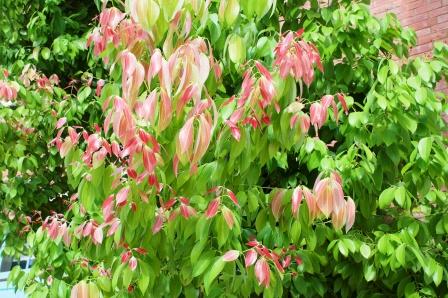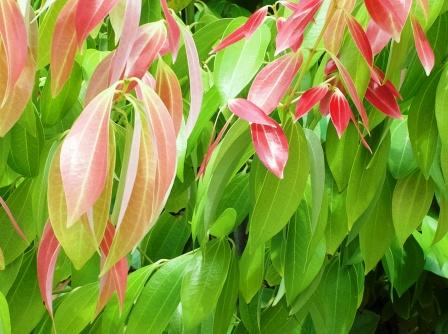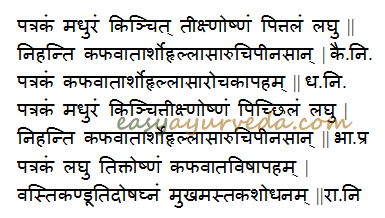Tejapatra – Cinnamomum tamala Uses, Research, Remedies
Tejpatra- Cinnamomum tamala is an Ayurveda herb mentioned for the treatment of bad odor from mouth, black spots on the face, dental caries, swelling, cough and in complications of tuberculosis.
Latin name- Cinnamomum tamala Nees.
Laurus nobilis
Family- Lauraceae
Table of Contents
Vernacular names
Names in different languages:
Hindi name- Tejpat, Dalchini, Silkanthi, Kikoa, Kirkiria, Taj kalam, Taj kalami, Talispatri
English name- Indian Bay leaf, Malabar leaf, Indian bark, Indian cassia
Assamese name- Dopatti
Arabic name- Sazij, Zarnab
Bengali name- Tejapat, Daruchini
Gujarathi name- Tamal patra, Tej
Kannada name- Patra, Dalchini
Marathi name- Tamalapatra, Daalchinitikki, Sambarapana
Malayalam name- Pacilla
Punjabi name- Tejpatra
Oriya name- Tejpatra
Tamil name- Talisapatri
Telugu name- Akupatri, Pattaakulu, Tallishapatri, Talisha
Tulu name- Ijin
Burmese name – Thitchabo,Thitkyabo
Danish name – Indish Laurbaerblad
Espernato name – Hinda Cinnamomo
Finnish name – Lauries des Indes
German name – Indisches Lorburblatt
Hungarian name – Indiai baberlevel
Japanese name – Tamara-nikkei, Tezipatto

Morphology
Morphology of Cinnamomum tamala:
Tejpatta is a small tree growing to a height of 20-30 feet and is seen all over South India and Sri Lanka in the temperate climate. The bark of the tree is little brittle when cut and is brown in color with good odor. The leaves are thick, 4 to 7 inch in length with deep vein like structure in the upper surface and have a strong odor when crushed. Flowers are seen in clusters and have a strong odor. Fruits are round; purple colored and has a single seed inside. Flowers are seen in the month of January and the fruits appear in the month of May-August. Mainly three varieties of Tejpatra are available- Indian, Sinhalese and Chinese.

Properties, part used, dosage
Medicinal properties of Indian Bay leaf:
Rasa (Taste) – Katu (Pungent), Tikta (Bitter), Madhura (Sweet)
Guna (Qualities) – Laghu (Light for digestion), Ruksha (Dry in nature), Teekshna (Strong)
Vipaka – Katu (Undergoes Pungent taste after digestion)
Veerya (Potency) – Ushna (Hot)
Karma (Actions) – Kaphavata shamaka (reduces vitiated kapha and vata dosha), Pittavardaka (Increases pitta dosha)
Pharmacological action – Antibacterial, Hypoglycemic, Antioxidant, Antifungal, Hypolipidemic
Part used- Leaf, Bark, Oil
Dosage-
Bark powder- 1 to 3 g
Leaf powder- 1 to 3 g
Oil – 2 to 5 drops
Chemical composition
The oil from bark contains cinnamaldehyde (70–85%) as major constituent. Leaves from Nepal yield a volatile oil, containing mainly linalool 54.55%; cinnamaldehyde 1.45%, alpha-and beta-pinene, p- cymene and limonene. In essential oil from the leaves, mostly monoterpenoides were found. Linalool [50%] is a major compound.α-pinene, p- cymene and limonene range around 5 – 10% each. Phenylepropanides appear in little amount.
Uses of Tejpatra
- The dried leaf and bark of Tejpatra is used as spice in many cuisines all over the world.
- The powder of the bark of Cinnamomum tamala is used as tooth powder to treat dental caries, bad odor and gingivitis.
- Powder of the bark of Tejpatra is mixed with honey in a dose of 3- 5 g to treat cough and asthma.
- The oil extract of Cinnamomum tamala is used in a dose of 3 to 5 drops to treat dysmenorrhea and inflammation of the uterus.
- The paste of the bark of the plant is applied as paste over the area affected with swelling and pain.
- The oil of the herb is given in a dose of 3 to 6 drops to treat health complications arising out of tuberculosis.
- The cold infusion of the bark of Cinnamomum tamala is given in a dose of 30-40 ml to improve the strength of cardiac muscles and stimulate the renal function.
- Running nose – powder of cinnamon, patra, black pepper, cardamom should be inhaled.
- Obesity – An ointment of patra, agaru, usheera and chandana removes foul smell of body in case of obesity (Vrinda madhava)
- It is used in preparation of anjana, hence used in various cosmetics. It is aromatic drug, hence used as one of sugandhadravyas.
- Compound pill is used in kaasa, flatulence and dyspepsia.
- Oil distilled from the leaves is used in flavoring sweets and confectionaries.
- It is used as stimulant
- Given in kwatha or churna in suppression of lochia (vaginal secretion) after child birth, with much benefit.
- Leaf is diuretic, good for liver and speen.
- Used in inflammation, sore eyes and stops salivation.
Sanskrit verse

Indications
Uses as per Ayurveda:
Teekshna – strong, piercing
Ushna – hot
Pittala – Increases Pitta Dosha
Laghu – light to digest
Kaphavatahara – Balances Kapha and Vata Doshas
Mukhashodhana – cleanses oral cavity
Mastakashodhana – cleanses facial skin,
Indicated in –
Arsha – haemorrhoids
Hrullasa – nausea
Aruchi – anorexia
Peenasa – rhinitis
Visha – Toxic conditions, poisoning
Bastiroga – diseases of urinarty tract
Kandu – itching, pruritis
Adverse effects
Increased use of Tejpatra can cause hyperacidity and oral ulcers.
Interaction with medicines, supplements
Can this be used while taking Homeopathic medicine?
Yes. This product does not react with homeopathic medicine.
Can
this medicine be continued while taking supplements like multivitamin tablets,
Omega 3 fatty acids etc?
Yes. Generally, this product goes well with most
of the dietary supplements. However, if you are taking more than one product
per day, please consult your doctor for an opinion.
With western
medicines
Seek your
doctor’s advice if you are taking this product along with other western
(allopathic / modern) medicines. Some Ayurvedic herbs can interact with modern
medicine.
If both Ayurvedic and allopathic medicines are advised together, then it is
best to take Allopathic medicine first, wait for 30 minutes and then take the
Ayurvedic medicine.
Ayurvedic medicines
Ayurvedic medicines containing Tejpatra:
Bangshil tablet: It is a proprietary Ayurvedic medicine used for the treatment of urinary tract infections, cystitis, urethritis, chronic vaginitis etc
Arjunin capsule: It is a proprietary Ayurvedic medicine used for the strengthening of cardiac muscle, reduce palpitation and improve the lung capacity during respiration.
Aptoiz syrup: It is a proprietary Ayurvedic medicine used as an appetizer and improves digestion.
Thyrocap capsules: It is a proprietary Ayurvedic medicine used for treatment of thyroid disorders.
Branchozen capsule: It is a proprietary Ayurvedic medicine used for treatment of productive and dry cough, respiratory infections and asthma.
Amirikalp gold: It is a proprietary Ayurvedic medicine in lehya form, used for treatment of respiratory infection, cough, anemia and improve the general health of the person.
Ajeerna pachana choorna: It is a proprietary Ayurvedic medicine in powder form used for digestion of the food, bloating of abdomen and regurgitation.
Lodhrasava: It is a liquid Ayurvedic medicine used in leucoderma, anemia and obesity.
Punarnavadyarishta: This is an ayurvedic medicine in liquid form used for the treatment of cardiac diseases, vertigo, constipation, urinary tract infection and fistula.
Kadalimadhusnuhee granules: It is a proprietary Ayurvedic medicine in powder form used for the treatment of Leucorrhoea, Gonorrhea, Cystitis, Dysmenorrhea, Genito-urinary infections,Infectious wounds and ulcers.
Laghupooga pak: Laghupoogapak is an Ayurvedic medicine, in paste form used in treatment of anorexia, vomiting, and post delivery period of women.
Research
Research articles related to Cinnamomum tamala:
Anti- ulcer, gastro protective activity: The present study was designed to study the antiulcer potential of 50% ethanolic extract of Cinnamomum tamala (EECT) on experimentally induced ulcer models like pylorus ligation, ethanol, and aspirin. The results of te present investigation reveal that in all three models studied, EECT (50,100 and 200 mg/kg,p.o) produced a dose-dependent significant protection against ulcer models in animals. The results indicated that ethanolic extract of Cinnamomum tamala shows significant antiulcer activity by inhibiting the gastric lesions and provides the significant gastroprotective effect which may be associated with its antioxidant property.
Anti- microbial activity: In the present study phytochemical constituents, elemental composition and antimicrobial potential of the crude methanolic extract of Cinnamomum tamala leaves were explored. Antimicrobial potential of the crude extract and its fractions i.e. aqueous, n-hexane, dichloromethane and isobutanol were tested against six gram-negative, three gram-positive bacterial strains and one fungal strain by agar well diffusion method. The evaluated extracts evaluated showed variedable degree of inhibition zones against all tested microbes except dichloromethane, aqueous fraction and crude extract which were completely inactive against Salmonella typhi.
Anti- depressant activity: The current study was designed to explore anxiolytic, antidepressant, and antistress actions of Cinnamomum tamala (CT) leaves (aqueous extract) in rats. CT at 400 mg/kg produced an antianxiety effect equivalent to lorazepam, in the elevated plus maze, open field, and social interaction tests among selected doses of the CT. CT at 400 mg/kg also induced an antidepressant activity similar to imipramine, in the behavioral despair, learned helplessness test, and tail suspension among selected doses of the CT. Moreover, CT at 400 mg/kg produced a significant antistress effect comparable to W. somnifera in water immersion-restraint stress by decreasing ulcer index, adrenal gland weight, and by normalizing the plasma levels of corticosterone, glucose, cholesterol, and triglyceride levels when related to stress control.
Sanskrit Synonyms
Utkat- It is strong
Dala, Tamala Patra, Patra- The leaf is used
Gopana, Surabhi gandha- Has a good odor
Sukumaraka, Tapasajam, Vasana, Vastramamshuka, Palasha, Romasha, Chadanam
Kalaskanda – Stem is dark in colour
Patram – Leaveas are the main useful part
Gandhapatrika – Leaves are having aromatic odour
Classical categorization
Bhavaprakasha- Karpooradi varga
Dhanvantari Nighantu- Shatapushpadi varga
Raja Nighantu- Pippalyadi varga
Kaiyyadeva Nighantu- Oushadhi varga
Nigantu Adarsha – Karpuradi varga
Madanapala Nigantu – Karpuradi varga
Priya Nigantu – Harthakyadi varga
Astanga Hridaya – Eladigana
Brihathg Nigantukara – Karpuradi varga
Shaligrama Nigantu – Harithakyadi varga
Scientific classification
Kingdom: Plantae
Order: Laurales
Family: Lauraceae
Genus: Cinnamomum
Species: C. tamala
Habitat
Mainly found in Himalayan region, south slopes of Himalayas, Khasi, Jaintia hills, west Bengal, Assam.
History
As the name indicates the main part used is patra.The main feature of patra is that it is aromatic,having dark green coloured three veined.Leaves yield aromatic oil which is having very good medicinal value.It is also called by the names like ‘pungent leaf’,’Indian bay leaf’,’Cinnomomum’.They were well-known to the Romans under the name Malobathrum and used both for perfumery and cooking.
Indian bay leaves were available during the middle ages and were used for bees brewing till the sixteenth century. In Moghul cooking style much used is made of sweet and aromatic spices,hence this Cinnomomum,cloves and cardamom are considered as most important spices.
Author:
Dr.B.K.Prashanth M.D (Ayu), Ph.D
E mail: [email protected]
Click to consult Dr Prashanth BK











3 comments
Rajanna
Dear doctor, thank you for the info. As I understand the leaf is known as TEJ PATTA and the bark is known as cinnamon bark. Also called as Dalchini. But here I see the name in Kannada as Patra and Dalchini. Bit confusing. Kindly clarify
Dr J V Hebbar MD(Ayu)Author
Both the leaves of cinnamon and leaves of cinnamon in Tamala are used in the name of tejapatra / tej patta
Satyan Namdhari
The word “dalchini” is used in Hindi and Urdu languages for cinnamon in bark form. Tejpatra/ Tejpatta is used for referring to the leafy spice. Use of dalchini in your articles on cinnamon and tejpatra is confusing.